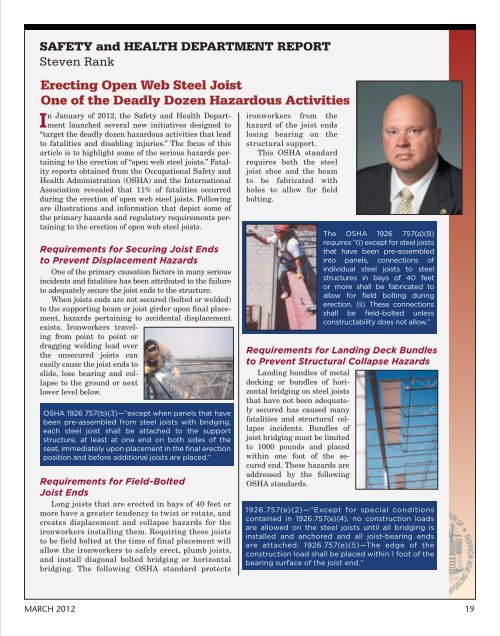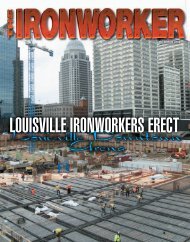2012 Iron Workers/IMPACT North American Labor-Management ...
2012 Iron Workers/IMPACT North American Labor-Management ...
2012 Iron Workers/IMPACT North American Labor-Management ...
Create successful ePaper yourself
Turn your PDF publications into a flip-book with our unique Google optimized e-Paper software.
SAFETY and HEALTH DEPARTMENT REPORT<br />
Steven Rank<br />
Erecting Open Web Steel Joist<br />
One of the Deadly Dozen Hazardous Activities<br />
In January of <strong>2012</strong>, the Safety and Health Department<br />
launched several new initiatives designed to<br />
“target the deadly dozen hazardous activities that lead<br />
to fatalities and disabling injuries.” The focus of this<br />
article is to highlight some of the serious hazards pertaining<br />
to the erection of “open web steel joists.” Fatality<br />
reports obtained from the Occupational Safety and<br />
Health Administration (OSHA) and the International<br />
Association revealed that 11% of fatalities occurred<br />
during the erection of open web steel joists. Following<br />
are illustrations and information that depict some of<br />
the primary hazards and regulatory requirements pertaining<br />
to the erection of open web steel joists.<br />
Requirements for Securing Joist Ends<br />
to Prevent Displacement Hazards<br />
One of the primary causation factors in many serious<br />
incidents and fatalities has been attributed to the failure<br />
to adequately secure the joist ends to the structure.<br />
When joists ends are not secured (bolted or welded)<br />
to the supporting beam or joist girder upon final placement,<br />
hazards pertaining to accidental displacement<br />
exists. <strong>Iron</strong>workers traveling<br />
from point to point or<br />
dragging welding lead over<br />
the unsecured joists can<br />
easily cause the joist ends to<br />
slide, lose bearing and collapse<br />
to the ground or next<br />
lower level below.<br />
OSHA 1926 757(b)(3)—“except when panels that have<br />
been pre-assembled from steel joists with bridging,<br />
each steel joist shall be attached to the support<br />
structure, at least at one end on both sides of the<br />
seat, immediately upon placement in the final erection<br />
position and before additional joists are placed.”<br />
Requirements for Field-Bolted<br />
Joist Ends<br />
Long joists that are erected in bays of 40 feet or<br />
more have a greater tendency to twist or rotate, and<br />
creates displacement and collapse hazards for the<br />
ironworkers installing them. Requiring these joists<br />
to be field bolted at the time of final placement will<br />
allow the ironworkers to safely erect, plumb joists,<br />
and install diagonal bolted bridging or horizontal<br />
bridging. The following OSHA standard protects<br />
ironworkers from the<br />
hazard of the joist ends<br />
losing bearing on the<br />
structural support.<br />
This OSHA standard<br />
requires both the steel<br />
joist shoe and the beam<br />
to be fabricated with<br />
holes to allow for field<br />
bolting.<br />
The OSHA 1926 757(a)(8)<br />
requires “(i) except for steel joists<br />
that have been pre-assembled<br />
into panels, connections of<br />
individual steel joists to steel<br />
structures in bays of 40 feet<br />
or more shall be fabricated to<br />
allow for field bolting during<br />
erection. (ii) These connections<br />
shall be field-bolted unless<br />
constructability does not allow.”<br />
Requirements for Landing Deck Bundles<br />
to Prevent Structural Collapse Hazards<br />
Landing bundles of metal<br />
decking or bundles of horizontal<br />
bridging on steel joists<br />
that have not been adequately<br />
secured has caused many<br />
fatalities and structural collapse<br />
incidents. Bundles of<br />
joist bridging must be limited<br />
to 1000 pounds and placed<br />
within one foot of the secured<br />
end. These hazards are<br />
addressed by the following<br />
OSHA standards.<br />
1926.757(e)(2)—“Except for special conditions<br />
contained in 1926.757(e)(4), no construction loads<br />
are allowed on the steel joists until all bridging is<br />
installed and anchored and all joist-bearing ends<br />
are attached. 1926.757(e)(5)—The edge of the<br />
construction load shall be placed within 1 foot of the<br />
bearing surface of the joist end.”<br />
MARCH <strong>2012</strong> 19




